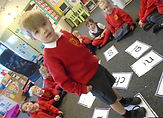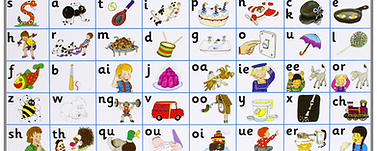

Our scheme is made up of 6 phases. We would expect the children to have completed phase 1 by the time they come to school and this phase is developed alongside phase 2 and 3 in reception. Phase 2 is the teaching of single sounds where the children get daily opportunities to read and record these sounds, moving on to reading CVC words too. The children are taught to recognise these sounds within words and they use their ‘Phonics Fingers’ and ‘Blending Hands’ to blend sounds together to begin to read CVC words.

Phase 3 is where the children begin to learn their digraphs (two letters which make one sound, e.g. ‘sh’). These sounds are introduced to the children and practiced in the same way as phase 2, with the added challenge of sentence reading and writing. We expect children in reception to have completed phase 3 and be within phase 4 by the end of the year.

Within year 1 and 2, phase 4, 5 and 6 are then taught. Phase 4 is used to consolidate the sounds that the children have previously learnt and to begin the teaching of consonant blends (sp, cr). They follow the same structure and use the same resources as the previous phases. Phase 5 will continue to teach the children alternative spellings to digraphs and how and when to use these within their reading and writing. Phase 6 has a more grammatical focus, teaching the children how to read and spell words with common suffixes (ed, ing, ly), to read and use past tense correctly and teaching spelling and reading of longer words.

Phonics in KS2
Typically, children will leave the phonics programme by the end of KS1 and will move onto guided reading and working on developing their skills of comprehension, rather than the mechanics of readying. For those children who leave KS1 and enter KS2 not having fully grasped phonics, we provide additional daily phonic sessions to boost these children, to ensure that they get the skills they need to develop into confident worldly readers. These sessions are pitched at the level needed and are addressed in a more mature approach, to ensure that the children see these sessions as important reading lessons, rather than Phonics. These sessions are led by our Letters & Sounds trained staff.
Phonics

“To learn to read is to light a fire; every syllable that is spelled out is a spark.”
Victor Hugo
Here at West Wittering School, the reading and sharing of a high quality text is a vital part of our curriculum, as we believe that from one good book, a love of reading can be born. Our youngest children right through to our oldest children are provided with daily opportunities to enjoy a range of books, both in the classroom and from our library. Reading is incorporated throughout our curriculum, with our book led topics, where a high quality and engaging book is the centre of all learning taking place within the classroom. Through these high quality texts, children’s vocabulary and comprehension is extended, which in turn, supports their writing. We aim to build a passion in reading for ALL our children.

Reading is taught explicitly in our classrooms, as well as being fed through all other subjects. The youngest children in the school begin their reading journey with phonics. This is a 20 minute daily session, which they access in as a year group. Our phonics lessons have been created in line with the Letters and Sounds Framework, following the structure and coverage outlined within it. We have created our structure and resources to ensure that the sessions are most effective for the children. Each phonics group use the same resources to ensure consistency as they move to the next phase and class. All adults have received Letters and Sounds Training to ensure, no matter which year group they are in, know and understand how phonics is run. We have created our own resources that directly meet the needs of OUR pupils at THEIR stage of learning.

